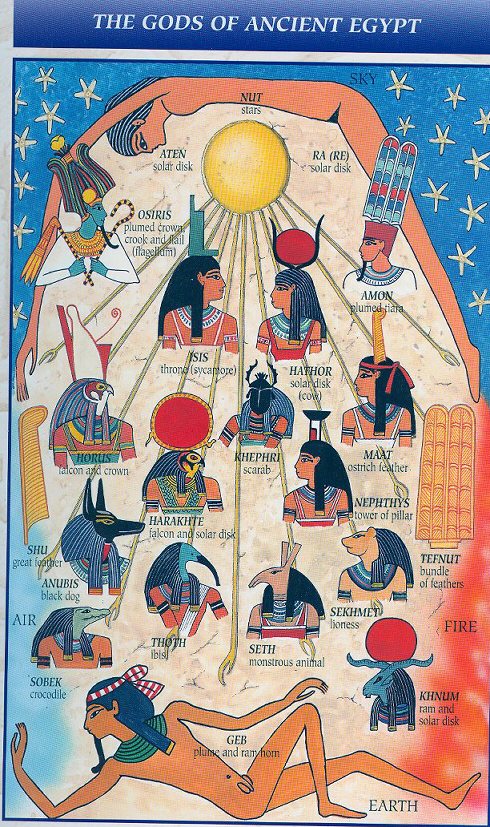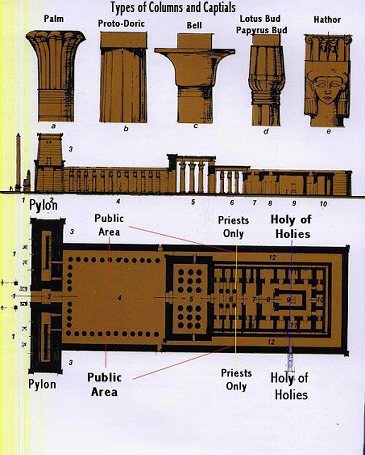The Gods of Ancient Egypt and Diagram of a Temple
You can't appreciate Egypt and understand the dynamics protrayed in the Temples and Tombs without a little understanding of the whose who. As some people would say, "You gotta know the players." Here is my overly simplified version of what you have to know.
Once upon a time there were two brothers, Seth and Osiris who were the sons of Ra, the father of all gods. Ra is depicted as the sun, or solar disk. Seth, the evil one, is represented as a man with the head of some monstrous animal or frequently as a hippo because a hippo was a large animal floating in the Nile who often killed Egyptians who were bathing or fishing. Osiris, our hero, looks like a green faced mummy with his arms crossed over his chest and holding the crook and flail (the sign of a pharaoh). Osiris was married to Isis, the divine mother, and she is depicted wearing a throne on her head. Seth was jealous of Osiris and made a sarcophagus of precious jewels and metals and told Osiris that if it fit him he could have it. Osiris climbed in and layed down in the sarcophagus and it was a perfect fit (surprise!). Seth immediately put the heavy stone lid on the sarcophagus and threw it in the Nile. (If you start thinking of Cain and Able you are not alone.) Oh, weeping and wailing did take place. Nephthys, Isis's sister was so distrait and overwhelmed at Osiris'death, and her sister's loss, that she become known as the goddess who protects coffins and mourns for the dead. She is frequently shown with a pillar on her head to represent the pillar of strength.
If I am getting any of this wrong too bad; its my story and I'm sticking to it. It gets stranger......
Now, Isis sets out to search for her dead husband in the Nile and the evil Seth goes one step further and cuts up Osiris' body into 14 pieces. Naturally, being in the river for a long time causes Osiris to lose some color and maybe that is why he is always depicted as being green and wrapped up like a mummy. Anyway, Isis finds 13 of the 14 pieces of Osiris and puts him back together again. The one piece she was never able to find was his "manly organ." (Honestly, I didn't make up this story and I'm trying hard to retain some family values.) Osiris and Isis now have an intimate relationship and a son, Horus (depicted as a falcon and crown since he is historically the mythical first pharaoh of Egypt, is born. (Now if this brings up images in your mind of a virgin birth don't blame me. These stories go back 4,000 years and even I couldn't make up this kind of thing.)
Horus is now the good guy and god of everything that is right and good in the world. But, Seth, his evil uncle, still has to be dealt with. Horus sets out to kill his uncle (sounds like Hamlet doesn't it?) and a great battle takes place. Horus looses his eye in the battle and you often see his eye depicted as a good luck charm. Horus is successful in capturing Seth - depicted as a hippo in one wall relief we saw - and offers him to his father Osiris. The moral of the story is that a mere mortal can't defeat evil without invoking the assistance of Horus.
Have I captured your interest and sparked your imagination?
Osiris now becomes the god of the underworld - the perfect job for a guy with a green face.
Horus is not to be left alone throughout eternity so he marries Hathor who is depicted as a woman with cow's ears. I haven't quite figured that one out yet.
Here is a schematic representation of the essentiial gods.

The four most important gods are Osiris, Isis, Horas and Hathor. But, naturally, there is always a catch - everyone didn't always depict the gods in these forms. Sometimes there were changes just to throw you off. Such as, Ra is always shown as having the sun above his head. Sometimes he is depicted as a falcon with the sun between two horns. Sometimes the sun is being pushed by a dung beetle on each side to represent the sun being pushed across the sky. Horus is also depicted as a falcon but he seems to always wear the crown up upper and lower Egypt. Now don't get confused.
As you can see in the illustration there are a lot of other gods involved in this mythological menagerie. But, with this basic understanding you should be able to wade ashore at any point on the Nile and understand what is going on.
![]()

It is also important to understand
the basic structure of a Temple
.

The Temple was entered through a large gate between a set of Pylons. Access to the Temple areas by the general public was greatly restricted. They could enter the large court which would frequently be lined with tall columns. The statue of the god to whom the temple was dedicated, and the sacred bark, would be preserved in the Holy of Holies and access was restricted to priests and the Pharaoh. The public was allowed to enter the uncovered corridor which surounded the Holy of Holies. Thus the public could hear any ceremony but not see what was happening. The exterior walls of the Holy of Holies, and the opposite wall forming the exterior of the Temple, would be carved in relief with stories of the gods and Pharaohs.
Jump Station
Jump Station
Jump Station
Go to The Egyption Museum of Cairo - Under Construcion
Go to The Religious Faiths - Under Construction Go to Street Scenes of Cairo - Under Construction Go to Who are the Gods? - Under Construction. Go to Chapter 9: The Khan el-Khali Bazaar - Under Construction Go to Chapter 8: The Pyramids - Under Construction Go to Chapter 7: East Thebes and the Temple of Luxor - Under Construction Return to Chapter 6: The Pyramids.Return to Chapter 5: Karnak Temple at Luxor and the Temple of Hathor at Dendera.
>Return to Chapter 4: Kom Ombo, Edfu, Karnak and Dendera.
Return to Chapter 3: Cruising Down the Nile.
Return to Chapter 2: Abu Simbel and Aswan.
Return to Chapter 1: Introduction to Egypt.
Read about my version of The Gods of Egypt and Diagram of Temples.
Return to Belli's Home Page
![]()

Return to Chapter 6: The Pyramids.
Return to Chapter 5: Karnak Temple at Luxor and the Temple of Hathor at Dendera.
Return to Chapter 4: Kom Ombo and the Temple of Horus at Edfu.
Return to Chapter 3: Cruising Down the Nile.
Return to Chapter 2: Abu Simbel and Aswan.
Return to Chapter 1: Introduction to Egypt.
Go toMaps of Egypt and our Itinerary.
Return to Belli's Home Page
![]()
For more information about our travels write to![]() Belli.
Belli.
